|
Tuta absoluta (Meyrick)
Taxonomic position
Insecta: Lepidoptera: Gelechioidea: Gelechiidae: Gelechiinae: Gnorimoschemini
Common names
Tomato leaf miner, South American tomato moth, South American tomato pinworm, tomato borer
Host plants
Tuta absoluta prefers to feed on tomato, though other solanaceous plants, including potato, have been recorded as hosts. It is known to have many generations in a year and affects tomato in all growing stages.
Symptoms of damage
Larvae mine in the mesophyll of leaves and make irregular, papery mines. The larvae also mine apical buds and stems. In cases of heavy infestation, both green and red fruits are attacked and infested fruits show small holes on the surface and the larvae tunnel / mine below the surface.
Pupation takes place in soil or on plant parts such as leaves and stem. Adult moths are silvery brown with mottled wings.
Pest status
It is of South American origin and it is an invasive pest in several countries in Europe and Africa. This pest was recently detected in Pune, Maharashtra. Subsequently, infestation has been noticed in major tomato growing districts of Maharashtra such as Pune, Ahmadnagar, Dhule, Jalgaon, Nashik, and Satara. In Bangalore and Kolar areas of Karnataka too, this pest has been observed to cause moderate to severe infestation. If left unchecked, it could be a potential threat to tomato cultivation in India.
One predator, Nesidiocoris tenuis (Reuter) (Hemiptera: Miridae), commonly found on tomato, is an effective predator of this pest. Neochrysocharis formosa (Westwood) (Hymenoptera: Eulophidae), a common parasitoid of serpentine leafminer of tomato in India and Southeast Asia, has been recorded as a
parasitoid of T. absoluta as well.
It is the latest invasive pest in India and was first recorded from Karnataka and Maharashtra in 2014. See this links Sridhar et al., 2014, Shashank et al., 2015 and also ICAR, 2015.
For information on natural enemies, see Ballal, C.R. et al., 2016.
For detailed information on diagnosis of T. absoluta, see Microlepidoptera on Solanaceae.
For invasive status in different parts of the world, see CABI Invasive Species Compendium.
Images
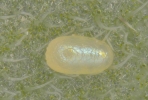
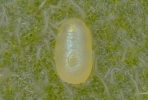
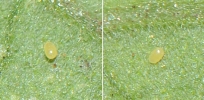 Eggs Eggs
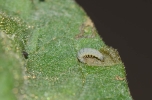

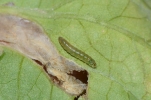

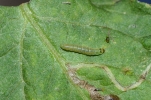
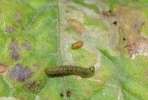
 Larvae Larvae
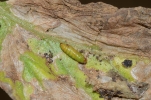
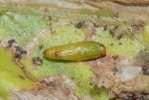
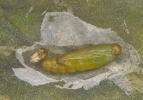 Pupae Pupae

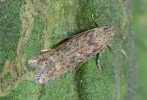
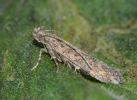
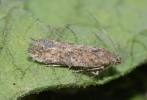

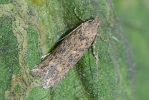
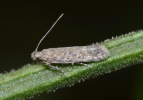 Adults
Adults
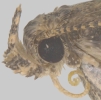 Head - labial palps Head - labial palps
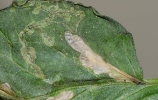 Leaf mined by Serpentine leaf miner and T. absoluta
Leaf mined by Serpentine leaf miner and T. absoluta
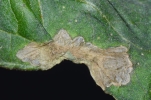
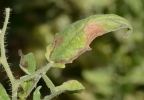
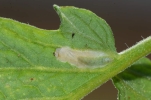
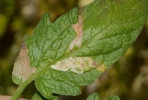
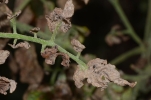 Leaf damage by Tuta absoluta Leaf damage by Tuta absoluta
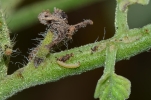

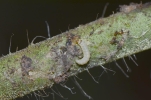
 Stem damage by Tuta
Stem damage by Tuta
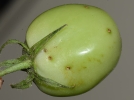

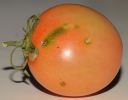

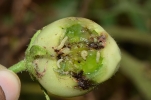 Fruit damage by Tuta
Fruit damage by Tuta

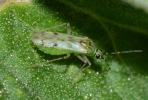

 Nesidiocoris tenuis (Reuter)
Nesidiocoris tenuis (Reuter)
 Neochrysocharis formosa (Westwood)
Neochrysocharis formosa (Westwood)
References
Ballal C R, Gupta A, Mohan M, Lalitha Y, and Verghese A. 2016.
The new invasive pest Tuta absoluta (Meyrick) (Lepidoptera: Gelechiidae) in India and its natural enemies along with evaluation of Trichogrammatids for its biological control. Current Science, 00113891: 110(11).
ICAR, 2015. Tuta absoluta: A new invasive pest alert. Indian Council of Agricultural Research New Delhi, India, 2015.
Shashank PR, Chandrashekar K, Meshram NM, Sreedevi K, 2015. Occurrence of tuta absoluta (Lepidoptera: Gelechiidae) an invasive pest from India. Indian Journal of Entomology, 77(4):323-329.
Shashank PR, Sachin S Suroshe, Singh PK, Chandrashekar K, Suresh M Nebapure and
Meshram NM, 2016. Report of invasive tomato leaf miner, Tuta absoluta (Lepidoptera: Gelechiidae) from northern India. Indian Journal of Agricultural Sciences, 86(12): 1635-6.
Sridhar V, Chakravarthy AK, Asokan R, Vinesh LS, Rebijith KB, Vennila S, 2014. New record of the invasive South American tomato leaf miner, Tuta absoluta (Meyrick) (Lepidoptera: Gelechiidae) in India. Pest Management in Horticultural Ecosystems, 20(2):148-154.
|